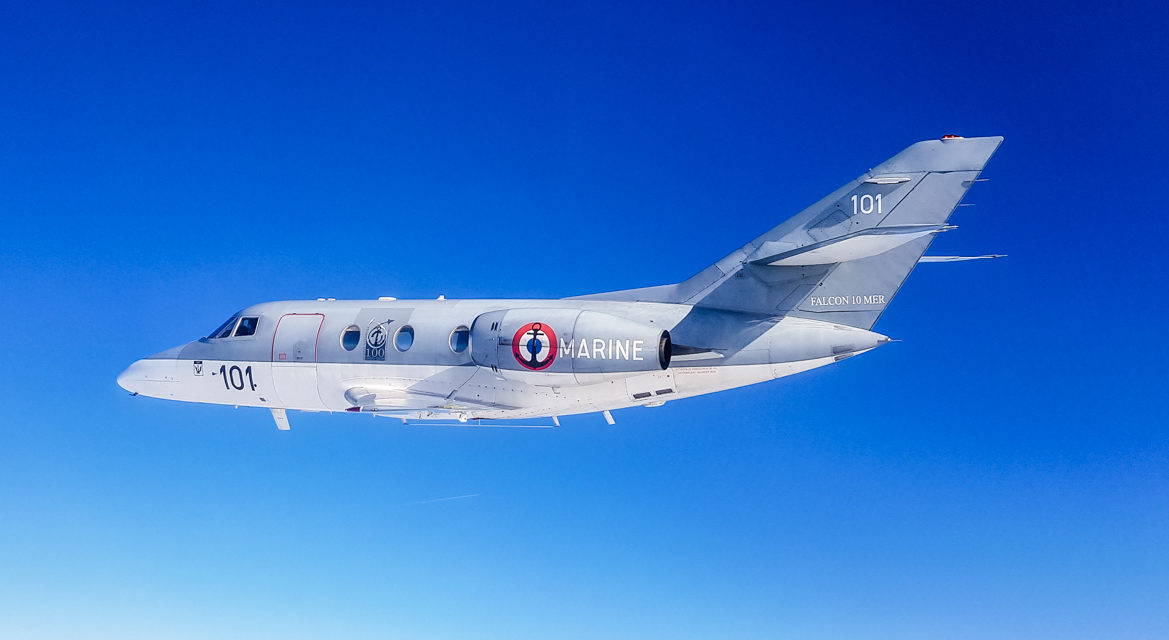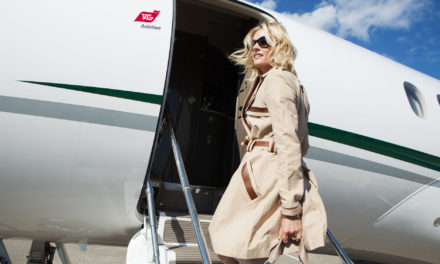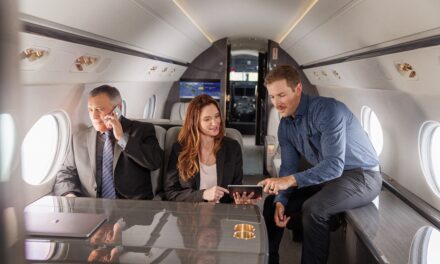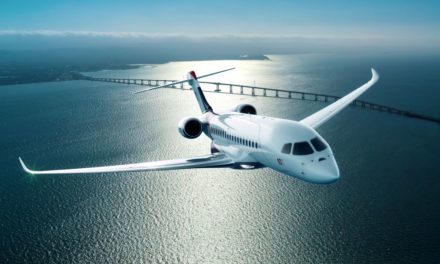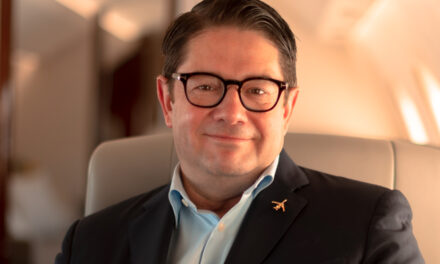By Fred Vergneres
The Falcon 10 Mer discreetly celebrated forty years of service in the French Navy. More than a simple business jet, the Falcon 10 within the very prestigious and no less discreet Escadrille 57S, have become, over the last four decades, an essential vector for pilots in fighter jet professionalization.
Generally, the public has a distinct image of the jets, which can be summed up by the Rafale taking off from the flight deck of the aircraft carrier Charles De Gaulle. However, this image cannot be far from a more complex reality, where the training and instruction of pilots in certain procedures remains preponderant throughout their careers. To this end, the French Navy has been operating the brand’s small twin-engine cloverleaf jet since 1973. Originally designed as a light business jet, it soon proved to be a true small fighter, with exceptional performance.
A business jet with the performance of a fighter jet
The Falcon 10 was designed in 1969, in order to complete the success story of the Falcon 20, and proved to be a particularly innovative aircraft, particularly in its design. Shorter than its predecessor, the Falcon 10 was in fact the first aircraft in France to have a three-dimensionally calculated wing, a small technological revolution at the time. In addition, the small twin-engine jet will become the first aircraft in the world to use carbon fiber for all of its wing cells. Building on its strengths, the smallest business jet ever produced in the Falcon range was certified in 1973. Later, its range, and more precisely its cruising speed of Mach 0.86, earned it the nickname “Corporate Bullet“. This led to a decision in 1972, when the French Navy authorities, looking for an aircraft capable of carrying out training missions for Super Etendard crews, selected this “business jet“. Over time, the Falcon 10 Mer will have shared its parking lots with four generations of machines: F-8E (FN) Crusader, Étendard, Super Étendard and Rafale.
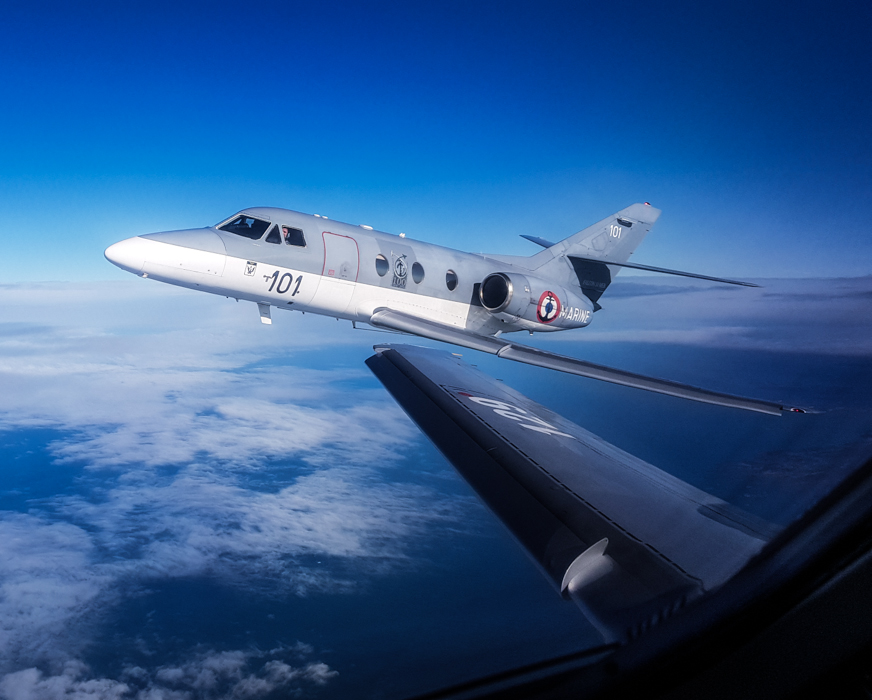
Dedicated to training
Nothing distinguishes a Falcon 10 Mer from a civilian version except the gray and white lining that it has worn since it entered service in 1975. This is because the Navy’s version is in fact totally similar to that of civilian operators, even from the point of view of its avionics. Its utilization within the naval forces, and more particularly within the Escadrille 57S, did not require any specific modifications. Indeed, the main mission of the aircraft is still the training of on-board fighter pilots on instrument use and French military procedures. As Frégate Captain François Daylaud, commanding officer of Escadrille 57S, points out: “The main purpose of the 57S is to train students who are returning from training in the United States, on flight procedures in the French territory. ». Following their selection at Lanvéoc, the fighter pilot students will follow a joint training with American pilots for two years at the Meridian base in Mississippi, which has been the process since 2006. While this curriculum, called “full US”, allows students to familiarize themselves with all American military techniques and procedures, and more broadly, those of NATO, disregarding the procedures that prevail in French territory. “Our students are re-trained on flying over land and sea with minima, which is totally different from that of the United States. The French regulatory framework is indeed very specific,” emphasizes François Daylaud. In fact, when the first “macaron” military pilots returned after 12 to 18 months in the US, the passage through the 57S was an required step, as a young pilot recently returning from Meridian pointed out: “The rules are not the same, and the French airspace is extremely dense. Switching to the 57S as soon as we returned from a two-week period allows us to rethink and learn about the regulations, which are totally different from those in the USA. ». The easy handling and performance of the Dassault twin-engine aircraft was perfectly adapted to this environment. Its speed and range of 3,500 km (1,922 nm) greatly facilitates the work of the instructors, who have a wide range of capabilities, so that they can truly test the capacity of the students’ knowledge, in addition to their ability to evolve in different French terrains. Beyond that, the business jet can also be used for low altitude adaptation flights at 500ft above the ground, which is a procedure that is generally forbidden in the USA. “On returning from the United States, the refresher course takes four weeks and includes six flights dedicated to instrument training, five flights over land, and between four and six flights over the sea, in order to brush up on low altitude learning and validate reflexes,” said the squadron commander. In parallel with training on French territory, the 57S conducts daily flights abroad to maintain its level of competence. It conducts training on and from Dublin airport, less than 45 minutes away from Landivisiau. “We try to carry out, as many as possible, regular training flights at all the major European airfields, not only for pilot training but also in the event that we have to convoy a high authority. These outings enable us to deal more regularly with sometimes very complex civil procedures, and also maintain the operational level of our crews,” comments Daylaud.
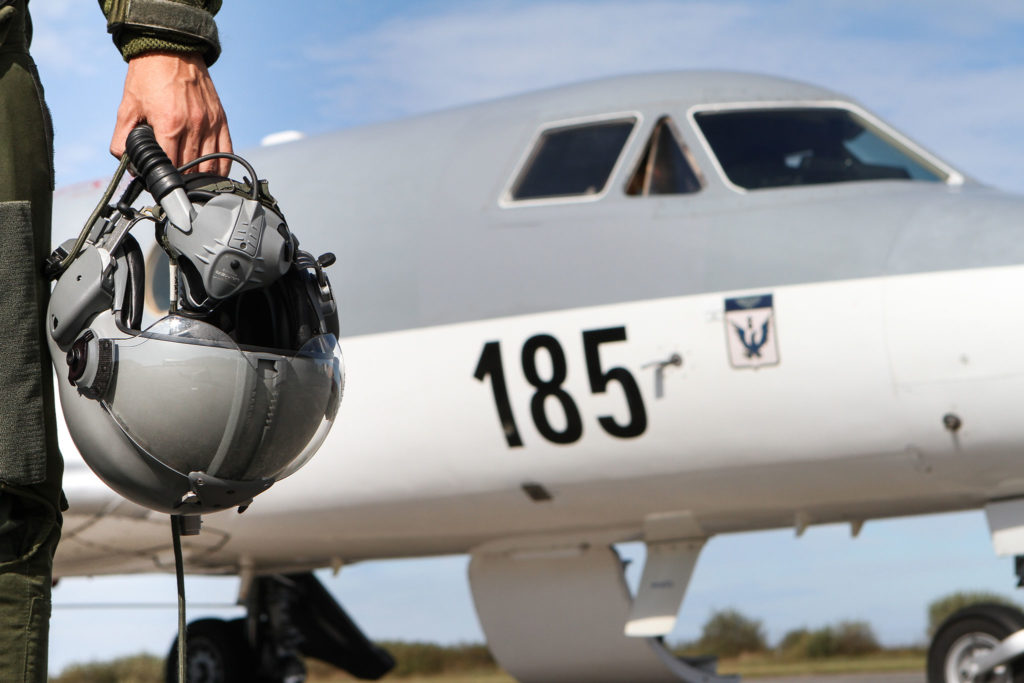
57S: from training to official transport
In addition to the “ab initio” training of young pilots, the 57S is also used to upgrade the instrument flight skills of pilots operating in the fleet. “Pilots on the Rafale come to us three times a year to validate their knowledge of IFR instrument flight,” said CF Daylaud, adding: “It’s a procedure they don’t use very much, so it’s important to conduct these flight tests so they can maintain or even improve their skills. “Although the Falcon 10 was chosen forty years ago, it appears that it has always been able to meet the operational requirements of the French Navy. Purchased to compensate for the lack of a dedicated two-seater fighter for training, the Falcon is nonetheless “a perfect learning tool that allows for quicker intervention on the controls, since the instructor is next to the student,” emphasizes the officer. The twin-engine remains all the more topical, as it allows sailors to use their aircraft in a less restrictive manner, while maintaining a more economic ratio per flight hour, compared to the training on fighter aircraft. From this fact, to saying that the French Navy was able to anticipate the budgetary problem from four decades ago, it’s only a step away. The 57S has an allocation of 1,800 hours per year for all these missions. In addition to the training of students and the recurrence of pilots already assigned, the hours also include the training of 57S crews, who currently have eight instructor pilots. “Pilots remain assigned to the squadron for an average of three years, meaning each year we have one-third of the pilots to train. “said CF Daylaud. In addition to training, 57S is also called upon to operate the Falcon 10 for liaison flights for the Navy’s senior authorities, as well as for government authorities. These missions involve crews flying to various European or Mediterranean theaters for about 200 hours a year. Backed by its pragmatism, which it has been claiming for at least 400 years, the Royal Air Force also entrusts Falcon 10 crews with the transportation of certain spare parts when a Navy aircraft needs to be repaired outside its base.
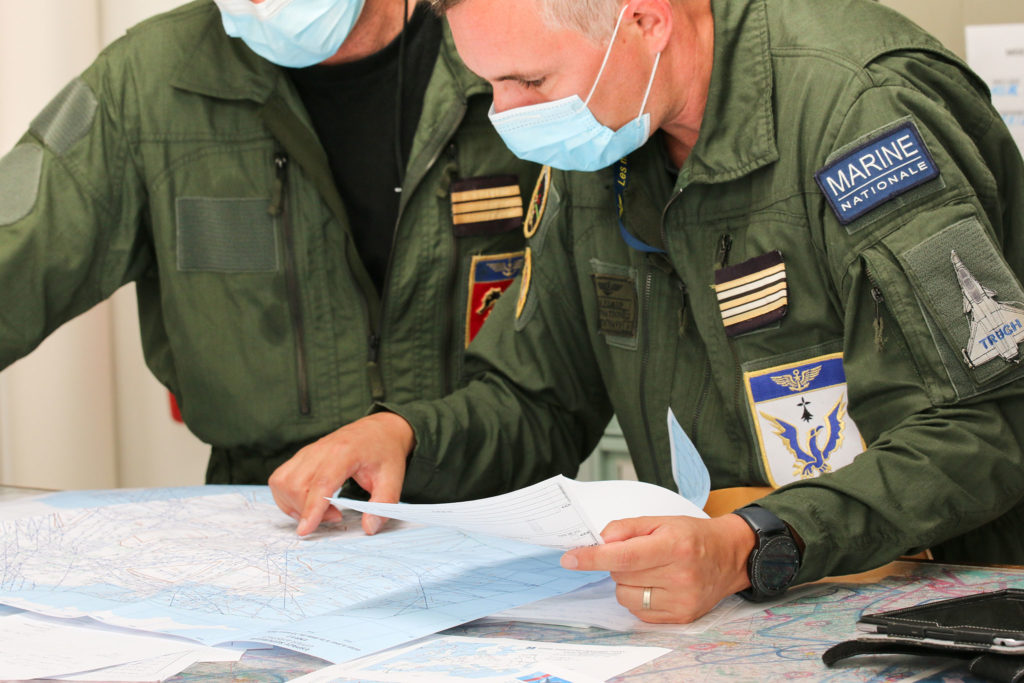
Maintenance in operational condition
Because of its flexibility, the Falcon 10 is one of the cornerstones of the naval aviation component. However, nothing would be possible without the personnel, who also led the 57S to become a separate unit in the French Navy’s organizational chart. According to its commander, “the unit is a mixture of cultures between the pilots from the on-board fighter and those from the multi-engine world, in this case the PatMar (maritime patrol). “This is a logical step, as the 57S reports directly to the PatMar command. Bringing the two worlds together “allows for emulation and an increase in IFR skills. This is an area that we have mastered perfectly, and in which we have become experts, relying in particular on a constant review of our knowledge in order to maintain a high level of competence,” adds the officer. The 57S relies on maintenance delegated to Sabena Technics to keep its six machines flying. In addition to rinsing the aircraft with fresh water after each mission over the sea to prevent corrosion, the company is also responsible for the airworthiness of the aircraft and their mechanical maintenance. A team of about ten people at the Landivisiau base are ready to intervene at any time to ensure that the aircraft remains in sufficient operational condition. “The contract with Sabena Technics specifies that four aircraft will be put on line at the site. Two other aircraft are currently stored at the industrial site in Dinard, in order to preserve their potential,” commented Capitaine de Frégate. Nevertheless, an airworthiness check is conducted by three Navy technicians. Despite a satisfactory availability rate, the aircraft is showing its age and spare parts are becoming scarce. However, in spite of its age, the Falcon 10 is still remotely monitored by Dassault, which answers certain technical questions when necessary. The number of aircraft still in use today enables the French Navy to “develop” a center of expertise for the aircraft and a significant asset in terms of feedback for civilian operators, with whom the unit remains in contact. These long-standing ties between the military operator and the civilian community enable the 57S to provide an important springboard for the professional careers of certain pilots who wish to move into the civilian sector on the Falcon 10, and more broadly in the Falcon family.
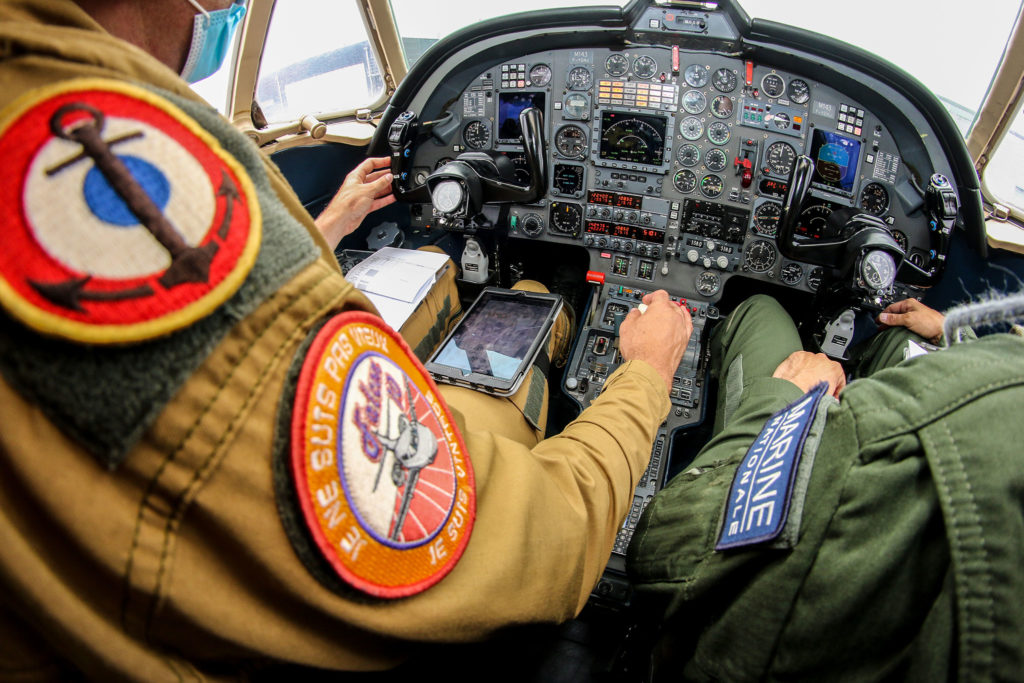
Renewal: a pragmatic choice
However, the longevity of the device has been made possible through modifications and improvements over these past four decades. One of the most important improvements, in terms of avionics was completed in 2008. The Navy has redesigned its avionics with the integration of EFIS screens to comply with GNSS (Global Navigation Satellite System) standards. The upcoming disappearance of the ILS in many areas, in addition to the requirement for a GPS approach system (LNAV) by integrating an antenna and new housing, should force the Navy to carry out new work on its fleet of aircraft. In any case, these will be the last possible modifications to the aircraft, which despite its performance, “is indeed showing its age,” as CF Daylaud points out adding that the aircraft “will not be able to withstand a more important transformation project, in particular the installation of ADS-B or CPDLC.” The complexity of such an operation would require an expense greater than the acquisition of four new aircraft. With this in mind, the Navy has begun looking at the successor to the twin-engine cloverleaf jet, via a replacement aircraft that it will find in the light jet segment. And, because of performance, only two aircraft available on the market stand out as replacements to the Falcon 10: the Embraer Phenom 300 and the Pilatus PC-24.
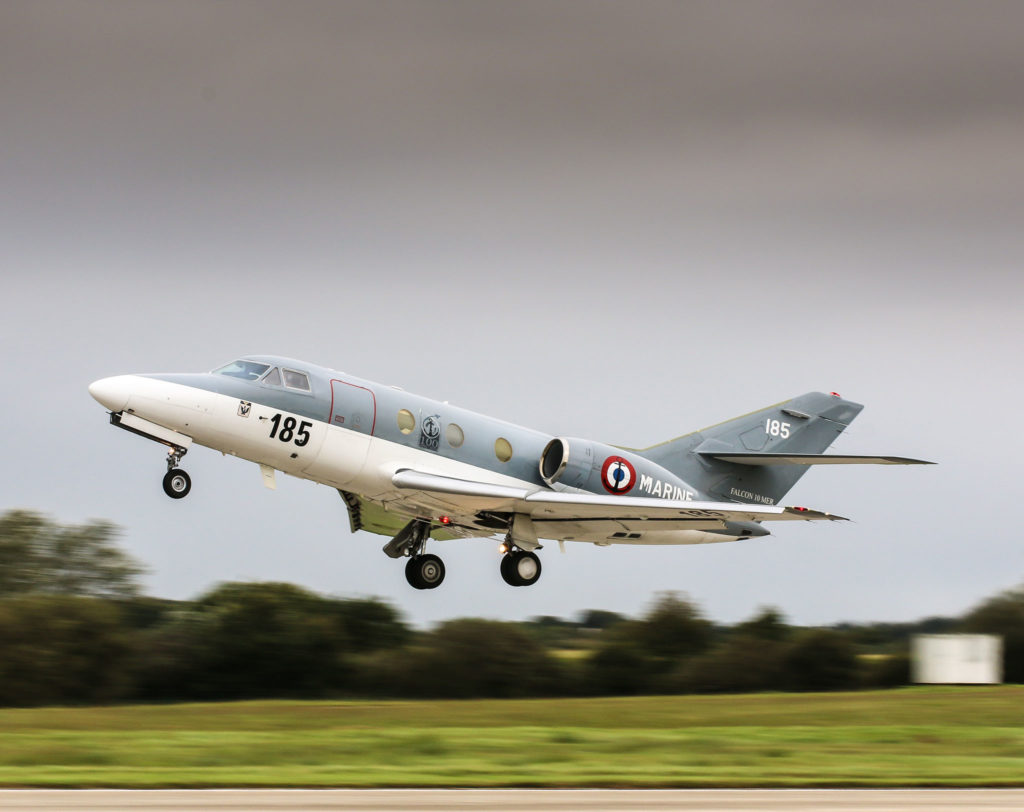
These two twin-engine jets paradoxically do not offer the same speed performance as the Falcon 10, but their avionics are very similar to that of the Rafale. Although studies have been under way by the staff for several months, a decision will not be taken before next year, and a project deadline of 2025, meaning the date at which time the state waivers must be granted for the Falcon 10 Mer to remain in flight.

